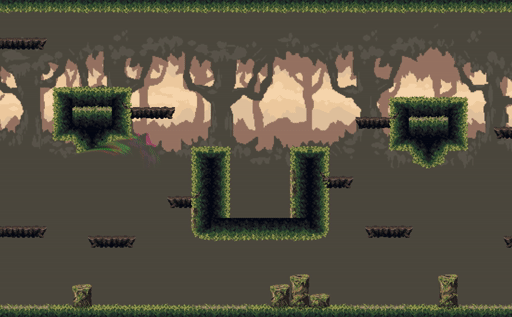(Almost) Invisible Character
Given a sprite, this shader gives it the ability to become invisible and fade into the background. But the ability is not flawless and the background is slightly deformed by the invisibility cloaking.
The shader offers two uniforms:
- alpha, ranging from 0 (no cloaked) to 1 (fully cloaked).
- dist, specifying the offset of the background in pixels.
Shader code
shader_type canvas_item;
const float pi = 3.14156;
uniform float dist = 16.;
uniform float alpha : hint_range(0., 1.) = 1.;
void fragment() {
vec2 backgroundUV = FRAGCOORD.xy * SCREEN_PIXEL_SIZE.xy;
vec2 offsetR = vec2(dist * SCREEN_PIXEL_SIZE.x * cos(TIME * 2. * pi), dist * SCREEN_PIXEL_SIZE.x * cos(TIME*0.7 * 2. * pi));
vec2 offsetG = vec2(dist * SCREEN_PIXEL_SIZE.x * cos(1. + (TIME * 2. * pi)), dist * SCREEN_PIXEL_SIZE.x * cos(3. + (TIME*0.7 * 2. * pi)));
vec2 offsetB = vec2(dist * SCREEN_PIXEL_SIZE.x * cos(TIME * 1.5 * pi), dist * SCREEN_PIXEL_SIZE.x * cos(TIME*0.9 * 2. * pi));
vec4 backColR = texture(SCREEN_TEXTURE, SCREEN_UV + offsetR);
vec4 backColG = texture(SCREEN_TEXTURE, SCREEN_UV + offsetG);
vec4 backColB = texture(SCREEN_TEXTURE, SCREEN_UV + offsetB);
vec4 texCol = texture(TEXTURE, UV);
COLOR = mix(texCol, texCol.a * vec4(backColR.r, backColG.g, backColB.b, 1.0), alpha);
}







shader_type canvas_item;
uniform sampler2D SCREEN_TEXTURE : hint_screen_texture,filter_linear_mipmap;
const float pi = 3.14156;
uniform float dist = 16.;
uniform float alpha : hint_range(0., 1.) = 1.;
void fragment() {
vec2 backgroundUV = FRAGCOORD.xy * SCREEN_PIXEL_SIZE.xy;
vec2 offsetR = vec2(dist * SCREEN_PIXEL_SIZE.x * cos(TIME * 2. * pi), dist * SCREEN_PIXEL_SIZE.x * cos(TIME*0.7 * 2. * pi));
vec2 offsetG = vec2(dist * SCREEN_PIXEL_SIZE.x * cos(1. + (TIME * 2. * pi)), dist * SCREEN_PIXEL_SIZE.x * cos(3. + (TIME*0.7 * 2. * pi)));
vec2 offsetB = vec2(dist * SCREEN_PIXEL_SIZE.x * cos(TIME * 1.5 * pi), dist * SCREEN_PIXEL_SIZE.x * cos(TIME*0.9 * 2. * pi));
vec4 backColR = texture(SCREEN_TEXTURE, SCREEN_UV + offsetR);
vec4 backColG = texture(SCREEN_TEXTURE, SCREEN_UV + offsetG);
vec4 backColB = texture(SCREEN_TEXTURE, SCREEN_UV + offsetB);
vec4 texCol = texture(TEXTURE, UV);
COLOR = mix(texCol, texCol.a * vec4(backColR.r, backColG.g, backColB.b, 1.0), alpha);
}